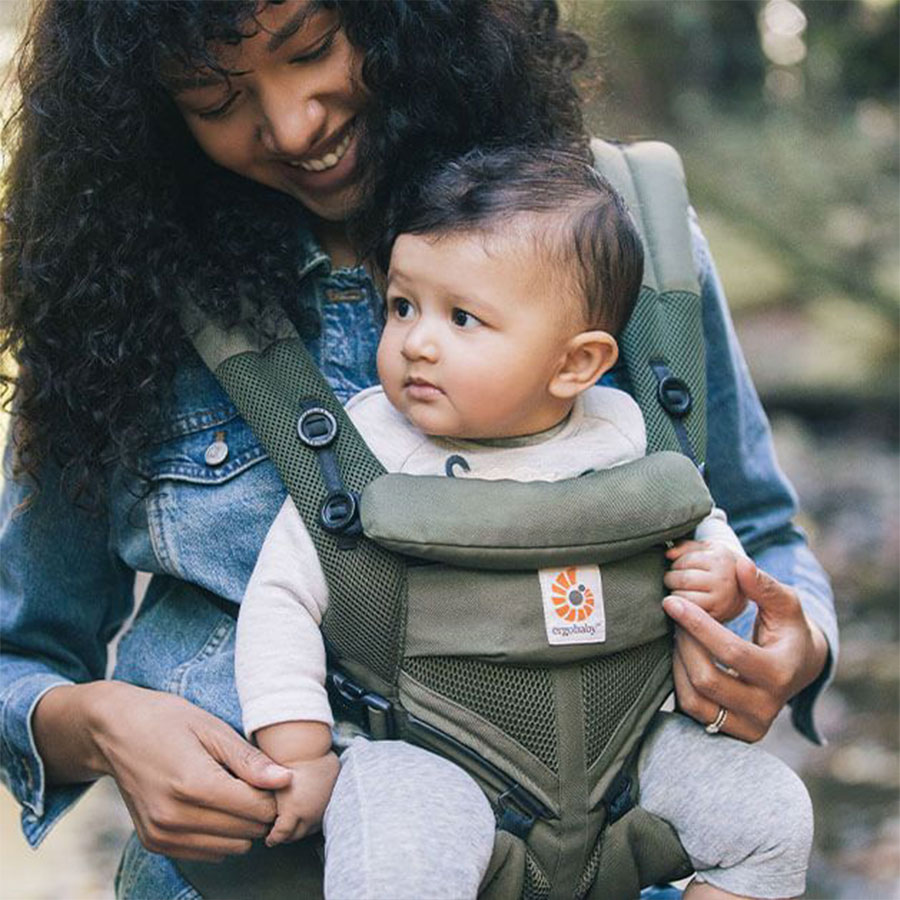
The Ergobaby Omni 360 Carrier is the Ergobaby Carrier that does everything. Ergobaby’s all-around carrier that has all the features you need. It can be used from newborn to toddler, it can be used in multiple carrying positions, it is made with premium materials and has premium features and award-winning designs. The Omni 360 is fully safety tested and credited as ‘Hip-Healthy’ by the Hip Dysplasia Institute.
There are several versions of the Ergobaby Omni 360 carrier. All have the same awesome design features and each work, and can be used, in exactly the same way. They differ in terms of the type or style of fabric used, from standard cotton to high-tec mesh fabric materials to help keep you cool.
The Ergobaby Omni is perfectly suitable for newborns. In fact, it was specifically designed to be used with newborns. The Omni doesn't need any additional infant inserts, or anything extra at all - it’s ready for your newborn when you take it out of the box.
One of the key features of the Omni 360 is the facing out position, and you'll be wondering when you can start using this position with your baby. It's a great position for curious babies
The Ergobaby Omni 360 baby carrier offers all carry positions, and can be used in the front carry position facing you or facing out, as well as hip and back carry positions. Please refer to the specific requirements for use and instructions for each carry position.
The Ergobaby Omni 360 baby carrier can be used with your newborn meeting the minimum weight and height requirements, in the front carry position facing you. Your newborn baby must weigh 7 lbs minimum (3.2 kg) and be at least 20 inches tall (50.8 cm).
The Ergobaby Omni 360 baby carrier has been specifically designed so you can carry your newborn baby (minimum 7 lbs / 3.2 kg) without the need of an infant insert. Easy to use, the Ergobaby Omni 360 carrier's bucket seat gradually adjusts to your growing baby from newborn to toddler (7-45 lbs / 3.2-20 kg) to support your baby in an ergonomic M-shape position at all ages. Please refer to the label on the waistbelt or instructions to adjust the seat based on your baby's height.
When to start facing-out or world-facing in the Omni is very much dependent on your baby’s development. As a guide, you can start wearing your baby facing out once your baby demonstrates strong head and neck control, with his chin above the carrier panel. Do not use a pillow to prop baby up. If baby gets sleepy or shows signs of overstimulation, turn baby around to face you.
As baby’s brain develops and their muscles strengthen, they may begin showing you signs that they want to face the world. It is important to remember there is no rush and inward facing can still offer an outward view for your child.
Once your baby can see above the front panel of the carrier when sitting in the carrier, has strong head & neck control, and has a natural curiosity to see and interact with the world, they are ready for front-outward carry. We recommend starting with short durations (5-10 minutes) to prevent over-stimulation. If baby shows signs of over-stimulation (zoned out, catatonic, fussy, tired) or sleepiness, just turn them back around to front-inward, so they can find comfort in their wearer and rest.
Babies can easily become overstimulated and overwhelmed, so while in the front outward facing position, if your baby becomes agitated or fussy, we recommend you switch back to parent-facing.
What Should I Bear In Mind When Carrying Baby in the Outwards Facing Position?
There are a few things to think about when carrying baby in the outwards facing position, and you should keep these in mind and be wary of them at all times.
- Only carry in the outwards-facing position for no longer than 15 minutes at a time.
- Do not carry in the outwards-facing position near nap-time.
- Do not allow baby to sleep in the forward-facing position.
- There is no forward-facing position that is safe for a sleeping baby - if your baby needs to sleep, change their position to parent-facing.
 5,467 Reviews
5,467 Reviews